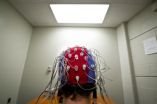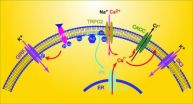(Press-News.org) EAST LANSING, Mich. — For the human brain, learning a new task when rules change can be a surprisingly difficult process marred by repeated mistakes, according to a new study by Michigan State University psychology researchers.
Imagine traveling to Ireland and suddenly having to drive on the left side of the road. The brain, trained for right-side driving, becomes overburdened trying to suppress the old rules while simultaneously focusing on the new rules, said Hans Schroder, primary researcher on the study.
"There's so much conflict in your brain," said Schroder, "that when you make a mistake like forgetting to turn on your blinker you don't even realize it and make the same mistake again. What you learned initially is hard to overcome when rules change."
The study, in the research journal Cognitive, Affective & Behavioral Neuroscience, is one of the first to show how the brain responds to mistakes that occur after rules change.
Study participants were given a computer task that involved recognizing the middle letter in strings such as "NNMNN" or "MMNMM." If "M" was in the middle, they were to press the left button; if "N" was in the middle, they were to press the right. After 50 trials, the rules were reversed so the participants had to press the right button if "M" was in the middle and the left if "N" was in the middle.
Participants made more repeated errors when the rules were reversed, meaning they weren't learning from their mistakes. In addition, a cap measuring brain activity showed they were less aware of their errors. When participants did respond correctly after the rules changed, their brain activity showed they had to work harder than when they were given the first set of rules.
"We expected they were going to get better at the task over time," said Schroder, a graduate student in MSU's Department of Psychology. "But after the rules changed they were slower and less accurate throughout the task and couldn't seem to get the hang of it."
Continually making these mistakes in the work environment can lead to frustration, exhaustion and even anxiety and depression, said Jason Moser, assistant professor of psychology and director of MSU's Clinical Psychophysiology Lab.
"These findings and our past research suggest that when you have multiple things to juggle in your mind – essentially, when you are multitasking – you are more likely to mess up," Moser said. "It takes effort and practice for you to be more aware of the mistakes you are missing and stay focused."
In addition to Schroder and Moser, co-researchers include Erik Altmann, associate professor of psychology, and master's student Tim Moran.
INFORMATION:
When rules change, brain falters
2012-07-30
ELSE PRESS RELEASES FROM THIS DATE:
Gene mutations linked to most cases of rare disorder -- Alternating Hemoplegia of Childhood
2012-07-30
(SALT LAKE CITY)—Alternating hemiplegia of childhood (AHC) is a rare disorder that usually begins in infancy, with intermittent episodes of paralysis and stiffness, first affecting one side of the body, then the other. Symptoms mysteriously appear and disappear, again and again, and affected children often experience dozens of episodes per week. As they get older, children fall progressively behind their peers in both intellectual abilities and motor skills, and more than half develop epilepsy. Unfortunately, medications that work for epilepsy have been unsuccessful in ...
Smell the potassium
2012-07-30
Kansas City, Missouri - The vomeronasal organ (VNO) is one of evolution's most direct enforcers. From its niche within the nose in most land-based vertebrates, it detects pheromones and triggers corresponding basic-instinct behaviors, from compulsive mating to male-on-male death matches. A new study from the Stowers Institute for Medical Research, published online in Nature Neuroscience on July 29, 2012, extends the scientific understanding of how pheromones activate the VNO, and has implications for sensory transduction experiments in other fields.
"We found two new ...
Cutting the graphene cake
2012-07-30
Sandwiching individual graphene sheets between insulating layers in order to produce electrical devices with unique new properties, the method could open up a new dimension of physics research.
Writing in Nature Materials, the scientists show that a new side-view imaging technique can be used to visualize the individual atomic layers of graphene within the devices they have built. They found that the structures were almost perfect even when more than 10 different layers were used to build the stack.
This surprising result indicates that the latest techniques of isolating ...
Cell receptor has proclivity for T helper 9 cells, airway inflammation
2012-07-30
BOSTON, MA—A research team led by Xian Chang Li, MD, PhD, Brigham and Women's Hospital (BWH) Transplantation Research Center, has shed light on how a population of lymphocytes, called CD4+ T cells, mature into various subsets of adult T helper cells. In particular, the team uncovered that a particular cell surface molecule, known as OX40, is a powerful inducer of new T helper cells that make copious amounts of interleukin-9 (IL-9) (and therefore called TH9 cells) in vitro; such TH9 cells are responsible for ongoing inflammation in the airways in the lungs in vivo.
The ...
Massachusetts Eye and Ear researchers discover elusive gene that causes a form of blindness from birth
2012-07-30
BOSTON (July 29, 2012) – Researchers from the Massachusetts Eye and Ear Infirmary, The Children's Hospital of Philadelphia, Loyola University Chicago Health Sciences Division and their collaborators have isolated an elusive human gene that causes a common form of Leber congenital amaurosis (LCA), a relatively rare but devastating form of early-onset blindness. The new LCA gene is called NMNAT1. Finding the specific gene mutated in patients with LCA is the first step towards developing sight-saving gene therapy.
LCA is an inherited retinal degenerative disease characterized ...
New discovery of how carbon is stored in the Southern Ocean
2012-07-30
A team of British and Australian scientists has discovered an important method of how carbon is drawn down from the surface of the Southern Ocean to the deep waters beneath. The Southern Ocean is an important carbon sink in the world – around 40% of the annual global CO2 emissions absorbed by the world's oceans enter through this region.
Reporting this week in the journal Nature Geoscience, scientists from British Antarctic Survey (BAS) and Australia's national research agency, the Commonwealth Scientific and Industrial Research Organisation (CSIRO), reveal that rather ...
Gene discovery set to help with mysterious paralysis of childhood
2012-07-30
DURHAM, N.C. – Alternating hemiplegia of childhood (AHC) is a very rare disorder that causes paralysis that freezes one side of the body and then the other in devastating bouts that arise at unpredictable intervals. Seizures, learning disabilities and difficulty walking are common among patients with this diagnosis.
Researchers at Duke University Medical Center have now discovered that mutations in one gene cause the disease in the majority of patients with a diagnosis of AHC, and because of the root problem they discovered, a treatment may become possible.
The study ...
Giant ice avalanches on Iapetus provide clue to extreme slippage elsewhere in the solar system
2012-07-30
"We see landslides everywhere in the solar system," says Kelsi Singer, graduate student in earth and planetary sciences in Arts & Sciences at Washington University in St. Louis, "but Saturn's icy moon Iapetus has more giant landslides than any body other than Mars."
The reason, says William McKinnon, PhD, professor of earth and planetary sciences, is Iapetus' spectacular topography. "Not only is the moon out-of-round, but the giant impact basins are very deep, and there's this great mountain ridge that's 20 kilometers (12 miles) high, far higher than Mount Everest.
"So ...
Magnetic field, mantle convection and tectonics
2012-07-30
On a time scale of tens to hundreds of millions of years, the geomagnetic field may be influenced by currents in the mantle. The frequent polarity reversals of Earth's magnetic field can also be connected with processes in the mantle. These are the research results presented by a group of geoscientists in the new advance edition of "Nature Geoscience" on Sunday, July 29th. The results show how the rapid processes in the outer core, which flows at rates of up to about one millimeter per second, are coupled with the processes in the mantle, which occur more in the velocity ...
BGI reports the latest finding on NMNAT1 mutations linked to Leber congenital amaurosis
2012-07-30
July 29th, 2012, Shenzhen, China – A five-country international team, led by Casey Eye Institute Molecular Diagnostic laboratory, BGI and Zhejiang University School of Medicine First Affiliated Hospital identified the NMNAT1 mutations as a cause of Leber congenital amaurosis (LCA), one of the most common causes of inherited blindness in children. The latest study was published online in Nature Genetics, reporting the genetic characteristics underlying some LCA patients, and providing important evidences that support NMNAT1 as a promising target for the gene therapy of LCA.
LCA ...


